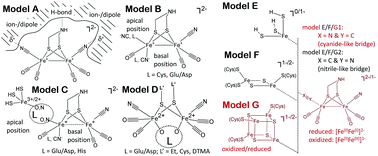当前位置:
X-MOL 学术
›
Dalton Trans.
›
论文详情
Our official English website, www.x-mol.net, welcomes your feedback! (Note: you will need to create a separate account there.)
Compositional and structural insights into the nature of the H-cluster precursor on HydF†
Dalton Transactions ( IF 4 ) Pub Date : 2018-06-19 00:00:00 , DOI: 10.1039/c8dt01654b Anna G. Scott 1, 2, 3, 4 , Robert K. Szilagyi 1, 2, 3, 4 , David W. Mulder 4, 5, 6, 7 , Michael W. Ratzloff 4, 5, 6, 7 , Amanda S. Byer 1, 2, 3, 4 , Paul W. King 4, 5, 6, 7 , William E. Broderick 1, 2, 3, 4 , Eric M. Shepard 1, 2, 3, 4 , Joan B. Broderick 1, 2, 3, 4
Dalton Transactions ( IF 4 ) Pub Date : 2018-06-19 00:00:00 , DOI: 10.1039/c8dt01654b Anna G. Scott 1, 2, 3, 4 , Robert K. Szilagyi 1, 2, 3, 4 , David W. Mulder 4, 5, 6, 7 , Michael W. Ratzloff 4, 5, 6, 7 , Amanda S. Byer 1, 2, 3, 4 , Paul W. King 4, 5, 6, 7 , William E. Broderick 1, 2, 3, 4 , Eric M. Shepard 1, 2, 3, 4 , Joan B. Broderick 1, 2, 3, 4
Affiliation

|
Assembly of an active [FeFe]-hydrogenase requires dedicated maturation enzymes that generate the active-site H-cluster: the radical SAM enzymes HydE and HydG synthesize the unusual non-protein ligands – carbon monoxide, cyanide, and dithiomethylamine – while the GTPase HydF serves as a scaffold for assembly of the 2Fe subcluster containing these ligands. In the current study, enzymatically cluster-loaded HydF ([2Fe]F) is produced by co-expression with HydE and HydG in an Escherichia coli host followed by isolation and examination by FTIR and EPR spectroscopy. FTIR reveals the presence of well-defined terminal CO and CN− ligands; however, unlike in the [FeFe]-hydrogenase, no bridging CO is observed. Exposure of this loaded HydF to exogenous CO or H2 produces no significant changes to the FTIR spectrum, indicating that, unlike in the [FeFe]-hydrogenase, the 2Fe cluster in loaded HydF is coordinatively saturated and relatively unreactive. EPR spectroscopy reveals the presence of both [4Fe–4S] and [2Fe–2S] clusters on this loaded HydF, but provides no direct evidence for these being linked to the [2Fe]F. Using the chemical reactivity and FTIR data, a large collection of computational models were evaluated. Their scaled quantum chemical vibrational spectra allowed us to score various [2Fe]F structures in terms of their ability to reproduce the diatomic stretching frequencies observed in the FTIR experimental spectra. Collectively, the results provide new insights that support the presence of a diamagnetic, but spin-polarized FeI–FeI oxidation state for the [2Fe]F precursor cluster that is coordinated by 4 CO and 2 CN− ligands, and bridged to an adjacent iron–sulfur cluster through one of the CN− ligands.
更新日期:2018-06-19



























 京公网安备 11010802027423号
京公网安备 11010802027423号